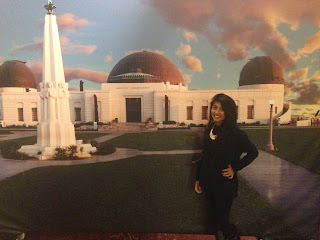My visit to the Griffith Observatory was nothing short of
spectacular. I have visited the Griffith before and I have been enthralled by
all the knowledge and beauty. However this time round, my experience was quite
different. I began to notice, all around me, the integration and overlap of
science and art.
Just as one enters, one sees the Observatory Pendulum, a
240-pound giant brass sphere suspended from a 40-foot steel wire. At first
glance this looks like nothing more than just a beautiful oscillating pendulum.
However, one quickly realizes that this is not simply a piece of art. A ring
magnet above the ceiling keeps the pendulum in motion, without influencing the
direction of its swing. Every ten minutes the pendulum knocks over a peg, but
in fact it is not the pendulum that has moved over to hit the peg. The earth
has moved the peg into the path of the swinging pendulum. The pendulum is
essentially disconnected from the turning of the earth and the earth rotes
beneath it, making it look as if the pendulum is changing the direction of its
swing. I thought it was so fascinating how much of artistic thought and effort
has gone into building this scientific object.
At the Griffith Observatory, one can also see the largest
astronomical image to ever be put on display called the Big Picture. It is an
astronomical photograph of a small sliver of the night sky and embedded in the
Big Picture are thousands of stars from our own Milky Way Galaxy. Looking at
this I could not help but think about how its creation was the result of the
two disciplines of art and science working together. While astronomers and
scientists were required to observe, study and plot the night sky, it was the
duty of the artists to perfectly capture and recreate what they had observed. If
not for the astronomers/scientists and the artists, the Big Picture would never
have been created with such accuracy and perfection.
The earth experiences four seasons because our planet is
tipped on its axis and the two poles point to the same direction in space all
year. Summer occurs on the hemisphere that is tipped towards the sun and our
seasonal weather depends on where we live. While I was always aware of this
knowledge, it was only now that I started thinking about how fascinating it was
that a purely scientific phenomenon is used by artists to convey emotion in
their works, be it in paintings, movies or short stories. Winter is used to
convey a sense of gloom and despair, summer suggests joy and freedom. Never
before had I really given much thought to this.
The last thing that I thought was super interesting was that
countless meteorites fall to the earth every year. However finding and
identifying them is tricky. While meteorite hunters are undoubtedly scientists,
they can also be considered subtle artists. Recognizing a meteorite is an art
because not all strange-looking rocks are meteorites. The meteorite hunters
must study the shape, size, surface, etc. of the rock to determine whether or
not it came from space.
This time round, my visit to the Griffith Observatory was
completely different. It was for the first time that I recognized how much of
art exists even in the context of space and the endless universe!





No comments:
Post a Comment